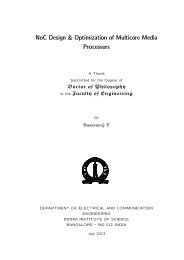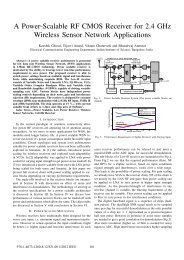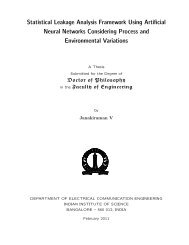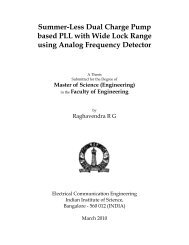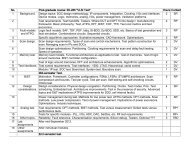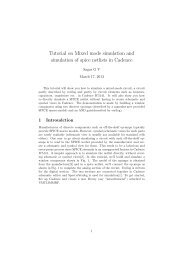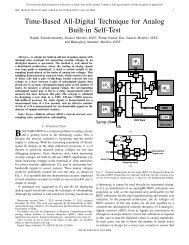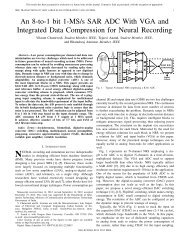This article has been accepted for inclusion in a future issue of this journal. Content is final as presented, with the exception of pagination.10 IEEE TRANSACTIONS ON VERY LARGE SCALE INTEGRATION (VLSI) SYSTE<strong>MS</strong>250250200150STH = disabledEAF = 1200150STH = "S0001000"EAF = 0.86100100501 1.1 1.2 1.3 1.4 1.5 1.6x 10 4250501 1.1 1.2 1.3 1.4 1.5 1.6x 10 4250200150100STH = "S0010000"EAF = 0.76200150100STH = "S0100000"EAF = 0.03501 1.1 1.2 1.3 1.4 1.5 1.6x 10 4501 1.1 1.2 1.3 1.4 1.5 1.6x 10 4Fig. 21. Measured digital output of the activity-dependent <strong>ADC</strong>. The x-axis <strong>and</strong> y-axis represent the time in μs <strong>and</strong> the output code, respectively. Theasymmetric rejection of the background noise is due <strong>to</strong> the fact that only five <strong>bit</strong>s were used <strong>to</strong> encode S TH .Relative <strong>ADC</strong> Power ConsumptionRelative Output <strong>Data</strong> Rate10.90.80.70.60.50.40.3σ n=100 mVrmsσ n=33.3 mVrmsσ n=133.3 mVrms0.20 50 100 150 200 25010080604020σ n=100 mV rmsσ n=33.3 mV rmsThreshold S TH(in codes)(a)σ n=133.3 mV rms00 50 100 150 200 250Threshold, S TH(in codes)Fig. 22. Relative reduction in power consumption (P max = 10.7 μW) <strong>and</strong>ODR with different σ n <strong>and</strong> S TH .Higher is the K eff,vga , more power efficient is the <strong>VGA</strong>.Table II presents the comparison of the <strong>VGA</strong> with that inthree state-of-the-art NRSs.(b)V. CONCLUSIONWe presented an 8-<strong>to</strong>-1 <strong>bit</strong>, 1 <strong>MS</strong>/s <strong>SAR</strong> <strong>ADC</strong> in UMC0.13-μm CMOS technology. <strong>An</strong> energy efficient DAC switchingscheme was proposed, which consumes the lowest power<strong>to</strong> date without using extra capaci<strong>to</strong>rs or clock cycles. TheDAC switching scheme consumes 37% less energy than thepresent state-of-the-art. For multichannel input, use of pingponginput sampling was emphasized <strong>to</strong> save power in <strong>VGA</strong><strong>and</strong> reference buffer. The proposed <strong>ADC</strong> also consumes lowerpower in clock buffers as we employ clock of half of thesampling speed. Also the resolution of the <strong>ADC</strong> can be variedbased on the dynamic range <strong>to</strong> avoid unnecessary processing<strong>and</strong> save power.For neural recording application, the ODR was reducedusing the proposed activity-dependent A/D scheme, whichkeeps important spike features preserved in the <strong>ADC</strong> output.This scheme saves both power <strong>and</strong> area when compared <strong>to</strong>spike feature extraction schemes, which employ complicatedon-chip DSP. The savings in power consumption of the <strong>ADC</strong><strong>and</strong> ODR due <strong>to</strong> the scheme are calculated <strong>and</strong> expressedin term of EAF. <strong>An</strong> experiment with the real neural datawas carried out <strong>to</strong> show the usefulness of the scheme forthe application. <strong>An</strong> emphasis was put on the requirement oflarge programmable voltage gain in the <strong>VGA</strong> for NRS. Thepresented <strong>VGA</strong> provides a voltage gain of 8 dB-35 dB ineight steps.The presented <strong>SAR</strong> <strong>ADC</strong> consumes 8.8 μW from 1 Vsupply <strong>and</strong> achieves ENOB of 7.7 <strong>bit</strong> for a near Nyquistinput at 1 <strong>MS</strong>/s speed. FlipDAC switching technique makesenergy consumption in the DAC small compared <strong>to</strong> digitalswitching energy. The DAC switching scheme will prove <strong>to</strong>be more beneficial in higher resolution <strong>and</strong> higher speed <strong>SAR</strong><strong>ADC</strong>s where the DAC switching energy is more comparable<strong>to</strong> the digital switching energy. The <strong>ADC</strong> achieves a FoM of42.3 fJ/conversion. The power consumption in the <strong>ADC</strong> is
This article has been accepted for inclusion in a future issue of this journal. Content is final as presented, with the exception of pagination.CHATURVEDI et al.: 8-TO-1 BIT 1-<strong>MS</strong>/s <strong>SAR</strong> <strong>ADC</strong> WITH <strong>VGA</strong> AND INTEGRATED DATA COMPRESSION 11dominated by digital switching, which will only improve withvoltage <strong>and</strong> technology scaling.REFERENCES[1] M. S. Chae, Z. Yang, M. Yuce, L. Hoang, <strong>and</strong> W. Liu, “A 128-channel6 mW wireless neural recording IC with spike feature extraction <strong>and</strong>UWB transmitter,” IEEE Trans. Neural Syst. Rehabil. Eng., vol. 17,no. 4, pp. 312–321, Aug. 2009.[2] R. Harrison, R. J. Kier, C. A. Chestek, V. Gilja, P. Nuyujukian, S. Ryu,B. Greger, F. Solzbacher, <strong>and</strong> K. V. Shenoy, “Wireless neural recordingwith single low-power integrated circuit,” IEEE Trans. Neural Syst.Rehabil. Eng., vol. 17, no. 4, pp. 322–329, Aug. 2009.[3] A. Sodagar, G. Perlin, Y. Yao, K. Najafi, <strong>and</strong> K. Wise, “<strong>An</strong> implantable64-channel wireless microsystem for single-unit neural recording,” IEEEJ. Solid-State Circuits, vol. 44, no. 9, pp. 2591–2604, Sep. 2009.[4] M. Yin <strong>and</strong> M. Ghovanloo, “A flexible clockless 32-ch simultaneouswireless neural recording system with adjustable resolution,” in Proc.IEEE Int. Solid-State Circuits Conf., Dig. Tech. Papers, Feb. 2009,pp. 432–433.[5] M. Azin, D. Guggenmos, S. Barbay, R. Nudo, <strong>and</strong> P. Mohseni, “Abattery-powered activity-dependent intracortical microstimulation IC forbrain-machine-brain interface,” IEEE J. Solid-State Circuits, vol. 46,no. 4, pp. 731–745, Apr. 2011.[6] R. Harrison <strong>and</strong> C. Charles, “A low-power low-noise CMOS amplifierfor neural recording applications,” IEEE J. Solid-State Circuits, vol. 38,no. 6, pp. 958–965, Jun. 2003.[7] V. Chaturvedi <strong>and</strong> B. Amrutur, “<strong>An</strong> area-efficient noise-adaptive neuralamplifier in 130 nm CMOS technology,” IEEE J. Emerg. Sel. TopicsCircuits Syst., vol. 1, no. 4, pp. 536–545, Dec. 2011.[8] W.-S. Liew, X. Zou, L. Yao, <strong>and</strong> Y. Lian, “A 1-V 60-μW 16-channelinterface chip for implantable neural recording,” in Proc. IEEE Cus<strong>to</strong>mIntegr. Circuits Conf., Sep. 2009, pp. 507–510.[9] J. McCreary <strong>and</strong> P. Gray, “All-MOS charge redistribution analog-<strong>to</strong>digitalconversion techniques. I,” IEEE J. Solid-State Circuits, vol. 10,no. 6, pp. 371–379, Dec. 1975.[10] G. Promitzer, “12-<strong>bit</strong> low-power fully differential switched capaci<strong>to</strong>rnoncalibrating successive approximation <strong>ADC</strong> with 1<strong>MS</strong>/s,” IEEE J.Solid-State Circuits, vol. 36, no. 7, pp. 1138–1143, Jul. 2001.[11] Y. Zhu. C.-H. Chan, U.-F. Chio, S.-W. Sin, U. Seng-Pan, R. P. Martins,<strong>and</strong> F. Maloberti, “A 10-<strong>bit</strong> 100-<strong>MS</strong>/s reference-free <strong>SAR</strong> <strong>ADC</strong> in 90 nmCMOS,” IEEE J. Solid-State Circuits, vol. 45, no. 6, pp. 1111–1121, Jun.2010.[12] M. van Elzakker, E. van Tuijl, P. Geraedts, D. Schinkel, E. Klumperink,<strong>and</strong> B. Nauta, “A 1.9 μW 4.4 fJ/conversion-step 10 b 1 <strong>MS</strong>/s chargeredistribution<strong>ADC</strong>,” in Proc. IEEE Int. Solid-State Circuits Conf., Dig.Tec. Papers, Feb. 2008, pp. 244–610.[13] Y.-K. Chang, C.-S. Wang, <strong>and</strong> C.-K. Wang, “A 8-<strong>bit</strong> 500-KS/s low power<strong>SAR</strong> <strong>ADC</strong> for bio-medical applications,” in Proc. IEEE Asian Solid-State Circuits Conf., Nov. 2007, pp. 228–231.[14] B. Malki, T. Yamamo<strong>to</strong>, B. Verbruggen, P. Wambacq, <strong>and</strong> J. Craninckx,“A 70 dB DR 10b 0-<strong>to</strong>-80<strong>MS</strong>/s current-integrating <strong>SAR</strong> <strong>ADC</strong> withadaptive dynamic range,” in Proc. IEEE Int. Solid-State Circuits Conf.Dig. Tech. Papers, Feb. 2012, pp. 470–472.[15] R. H. Olsson <strong>and</strong> K. Wise, “A three-dimensional neural recordingmicrosystem with implantable data compression circuitry,” IEEE J.Solid-State Circuits, vol. 40, no. 12, pp. 2796–2804, Dec. 2005.[16] B. Ginsburg <strong>and</strong> A. Ch<strong>and</strong>rakasan, “500-<strong>MS</strong>/s 5-<strong>bit</strong> <strong>ADC</strong> in 65-nmCMOS with split capaci<strong>to</strong>r array DAC,” IEEE J. Solid-State Circuits,vol. 42, no. 4, pp. 739–747, Apr. 2007.[17] T. <strong>An</strong><strong>and</strong>, V. Chaturvedi, <strong>and</strong> B. Amrutur, “Energy efficient asymmetricbinary search switching technique for <strong>SAR</strong> <strong>ADC</strong>,” Electron. Lett.,vol. 46, no. 22, pp. 1487–1488, Oct. 2010.[18] C.-C. Liu, S.-J. Chang, G.-Y. Huang, <strong>and</strong> Y.-Z. Lin, “A 10-<strong>bit</strong> 50-<strong>MS</strong>/s<strong>SAR</strong> <strong>ADC</strong> with a mono<strong>to</strong>nic capaci<strong>to</strong>r switching procedure,” IEEE J.Solid-State Circuits, vol. 45, no. 4, pp. 731–740, Apr. 2010.[19] A. Petraglia <strong>and</strong> S. Mitra, “<strong>An</strong>alysis of mismatch effects amongA/D converters in a time-interleaved waveform digitizer,” IEEE Trans.Instrum. Meas., vol. 40, no. 5, pp. 831–835, Oct. 1991.[20] I. Obeid <strong>and</strong> P. D. Wolf, “Evaluation of spike-detection algorithms for abrain-machine interface application,” IEEE Trans. Biomed. Eng., vol. 51,no. 6, pp. 905–911, Jun. 2004.[21] J. Vibert <strong>and</strong> J. Costa, “Spike separation in multiunit records: Amultivariate analysis of spike descriptive parameters,” Electroencephalograph.Clinical Neurophysiol., vol. 47, no. 2, pp. 172–182, 1979.[22] H. Semmaoui, J. Drolet, A. Lakhssassi, <strong>and</strong> M. Sawan, “Setting adaptivespike detection threshold for smoothed-teo based on robust statisticstheory,” IEEE Trans. Biomed. Eng., vol. 59, no. 2, pp. 474–482,Feb. 2012.[23] S. O’Driscoll, K. Shenoy, <strong>and</strong> T. Meng, “Adaptive resolution <strong>ADC</strong> arrayfor an implantable neural sensor,” IEEE Trans. Biomed. Circuits Syst.,vol. 5, no. 2, pp. 120–130, Apr. 2011.[24] L. Sumanen, M. Waltari, <strong>and</strong> K. Halonen, “A mismatch insensitiveCMOS dynamic compara<strong>to</strong>r for pipeline A/D converters,” in Proc. 7thIEEE Int. Conf. Electron., Circuits Syst., vol. 1. Dec. 2000, pp. 32–35.[25] V. Katyal, R. L. Geiger, <strong>and</strong> D. J. Chen, “A new high precision lowoffset dynamic compara<strong>to</strong>r for high resolution high speed <strong>ADC</strong>s,” inProc. IEEE Asia Pacific Conf. Circuits Syst., Dec. 2006, pp. 5–8.[26] W. Wattanapanitch <strong>and</strong> R. Sarpeshkar, “A low-power 32-channel digitallyprogrammable neural recording integrated circuit,” IEEE Trans.Biomed. Circuits Syst., vol. 5, no. 6, pp. 592–602, Dec. 2011.[27] M. Scott, B. Boser, <strong>and</strong> K. Pister, “<strong>An</strong> ultralow-energy adc for smartdust,” IEEE J. Solid-State Circuits, vol. 38, no. 7, pp. 1123–1129,Jul. 2003.[28] N. Verma <strong>and</strong> A. Ch<strong>and</strong>rakasan, “<strong>An</strong> ultra low energy 12-<strong>bit</strong> rateresolutionscalable <strong>SAR</strong> <strong>ADC</strong> for wireless sensor nodes,” IEEE J. Solid-State Circuits, vol. 42, no. 6, pp. 1196–1205, Jun. 2007.[29] M. Yip <strong>and</strong> A. Ch<strong>and</strong>rakasan, “A resolution-reconfigurable 5-<strong>to</strong>-10b 0.4-<strong>to</strong>-V power scalable <strong>SAR</strong> <strong>ADC</strong>,” in Proc. IEEE Int. Solid-State CircuitsConf. Dig. Tech. Papers, Feb. 2011, pp. 190–192.Vikram Chaturvedi (S’10) received the B.E. degreein electronics <strong>and</strong> telecommunication from the ShriGovindram Seksaria Institute of Technology <strong>and</strong> Science,Indore, India, in 2006. He is currently pursuingthe Ph.D. degree with the Electrical CommunicationEngineering Department, Indian Institute of Science,Bangalore, India.He was with ERC, Tata Mo<strong>to</strong>rs Ltd., where hewas involved in research on remote keyless entrysystem from 2006 <strong>to</strong> 2007. He presented a paper atthe SRP session of ISSCC 2010. His current researchinterests include adaptive biomedical systems, energy-efficient data converters,<strong>and</strong> high-speed serial interfaces.Mr. Chaturvedi was a recipient of the first Student Travel Grants byIEEE Solid-State Circuit Society (SSCS) as a recognition of early careeraccomplishments on solid-state circuits. He is a member of the SSCS <strong>and</strong>the IEEE Circuits <strong>and</strong> Systems Society.Tejasvi <strong>An</strong><strong>and</strong> (S’12) received the B.Tech. degreein electronics <strong>and</strong> communication from Guru GobindSingh Indraprastha University, New Delhi, India,<strong>and</strong> the M.Tech. degree in electronics design <strong>and</strong>technology from the Indian Institute of Science,Bangalore, India, in 2006 <strong>and</strong> 2008, respectively. Heis currently pursuing the Ph.D. degree with OregonState University, Corvallis.He was with the Cosmic Circuits <strong>and</strong> MicroelectronicsLabora<strong>to</strong>ry, Indian Institute of Science. Hiscurrent research interests include high-speed serialinterfaces, frequency synthesizers, <strong>and</strong> data converters.Bharadwaj Amrutur (M’08) received the B.Tech.degree in computer science <strong>and</strong> engineering fromthe Indian Institute of Technology Bombay, Mumbai,India, in 1990, <strong>and</strong> the M.S. <strong>and</strong> Ph.D. degrees inelectrical engineering from Stanford University, PaloAl<strong>to</strong>, CA, in 1994 <strong>and</strong> 1999, respectively.He was with Bell Labs, Agilent Labs, <strong>and</strong> GreenfieldNetworks. He is currently an Associate Professorwith the Department of Electrical CommunicationEngineering, Indian Institute of Science,Bangalore, India, where he is involved in researchon VLSI circuits <strong>and</strong> systems.




